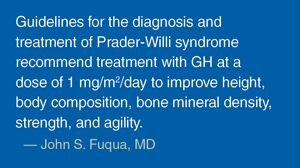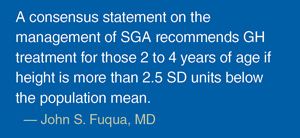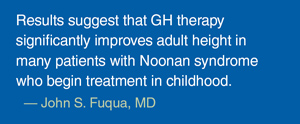Identifying Appropriate Patients for rhGH Therapy: Consulting Evidence-Based Guidelines
Recombinant human growth hormone (rhGH) was first approved for the treatment of growth hormone deficiency in 1985. Since then, rhGH has been approved for a variety of indications (Figure).1 As described in detail below, recent clinical trials, review articles, and evidence-based treatment guidelines have described the clinical use of rhGH for a number of pediatric conditions, including Prader-Willi syndrome, small for gestational age (SGA), idiopathic short stature (ISS), and Noonan syndrome.

The FDA indications for growth hormone treatment have expanded over the years.
Key: AGHD — adult growth hormone deficiency; AIDS — acquired immune deficiency syndrome; CRI — chronic renal insufficiency; GHD — growth hormone deficiency; ISS — idiopathic short stature; PWS — Prader-Willi syndrome; SGA — small for gestational age; SHOX — short stature homeobox gene deficiency
Source: Franklin SL, et al. Endocrinol Metab Clin North Am. 2009;38(3):587-611.
Click
here
for a larger view of this image.
Prader-Willi Syndrome
Prader-Willi syndrome is caused by a deletion of the paternal allele on the long arm of chromosome 15 (15q11-13), and has a reported incidence of approximately 1 per 10,000 to 12,000 live births.2 In infancy, these children have dramatic hypotonia that results in poor feeding, failure to thrive, and developmental delay.2 Between 18 and 24 months, they develop short stature as well as a significantly increased appetite, which will result in severe obesity if their caloric intake is not limited. In adolescence and adulthood, they also have hypogonadism. At all ages, they have abnormal body composition, with increased body fat and decreased lean mass.
The effects of GH therapy in patients with Prader-Willi syndrome have been examined, although no studies have examined the effects of treatment to adulthood. A study reported in 2002 examined 46 children with Prader-Willi syndrome who began treatment at a mean age of 11.9 years.3 The patients were initially randomized to receive either observation-only or GH at a dose of 1 mg/m2/day for 1 year. All patients then received GH at a dose of 1 mg/m2/day for 1 year, after which they were re-randomized to receive GH at a dose of 0.3, 1.0, or 1.5 mg/m2/day for another 2 years. Throughout the study, the investigators assessed height, body composition, energy expenditure, strength, and agility. During the first 2 years, patients randomized to GH had significantly lower mean body fat and higher lean body mass than control subjects. During the second 2 years, after re-randomization to 3 GH dose levels, the initial benefits associated with GH were maintained in the 2 higher dose groups, whereas body fat returned toward baseline values in the patients who received the lowest GH dose, and a slower gain in lean body mass was observed in this group. In addition to changes in body composition, GH therapy was associated with improved lipid levels, increases in resting energy expenditure, increases in strength and agility after the first 2 years, and increases in height velocity.
There have been several reports of sudden death within 6 months of treatment initiation in patients with Prader-Willi syndrome.4 However, sudden death is a well-recognized phenomenon in this patient population regardless of GH treatment status, often occurring in conjunction with a respiratory illness.5 The pathogenesis of sudden death is poorly understood, and may involve obstructive airway disease in association with abnormal central nervous system ventilatory control. The role of GH in this process is controversial and not well understood.

|
Guidelines for the diagnosis and treatment of Prader-Willi syndrome recommend treatment with GH at a dose of 1 mg/m2/day (approximately 0.23 mg/kg/week for an average-sized child) to improve height, body composition, bone mineral density, strength, and agility.6 The benefits of treatment are related more to body composition and neuromuscular function than height and are well established when treatment is initiated before 2 years of age, and possibly as early as 6 to 12 months. The guidelines recommend starting treatment at one-third to one-half the total dose, followed by gradual dose escalation. Sleep studies should be performed before and after treatment initiation, and if apnea is identified, it should be addressed prior to initiation of GH. Insulin-like growth factor (IGF)-1 should be monitored during the course of therapy to ensure that the levels are not abnormally high.
Children Born Small for Gestational Age
In contrast with Prader-Willi syndrome, a number of well-designed randomized clinical trials have examined the efficacy and safety of GH therapy for participants who were born SGA. Some of these studies included long-term control arms and treated participants until adult height was attained. A meta-analysis examined clinical outcomes for 391 patients who were enrolled in 4 randomized controlled clinical trials of GH therapy with continuing treatment until adulthood.7 The mean ages of the participants enrolled in these studies were 7.9 to 12.7 years at the start of therapy. Participants were required to have a birth weight or length at least 2 standard deviations (SD) below the population mean, and pre-treatment height at least 2 SD units below the normal mean value. GH doses in these studies ranged from 0.23 to 0.47 mg/kg/week.
Overall, the adult height of participants randomized to GH exceeded that of control participants by an average of 0.9 SD units; the final adult height values were 1.5 SD units below the mean for the GH group vs. 2.4 SD units below the mean for controls. Individuals who are born SGA are at higher risk of metabolic complications such as metabolic syndrome, hypertension, type 2 diabetes, and dyslipidemia. GH treatment may exacerbate some of these parameters. In this meta-analysis, metabolic disturbances were more likely in participants receiving GH therapy than in controls, but resolved after cessation of GH.

|
A consensus statement on the management of SGA published in 2007 recommends GH treatment for those 2 to 4 years of age if height is more than 2.5 SD units below the population mean. For patients older than 4 years of age, treatment should be considered if the height is more than 2 SD units below the mean.8 Treatment is not recommended for patients less than 2 years of age because approximately 85% of those born SGA will exhibit normal height by 2 years of age. The recommended starting dose is 0.25 to 0.49 mg/kg/week. A positive response is defined as a height velocity SD score greater than 0.5 after 1 year of treatment. Predictors of more favorable response include younger age, shorter stature, and higher GH dose.
Idiopathic Short Stature
There are approximately 50.4 million children under the age of 12 in the United States. By statistical definition, approximately 1.16 million (2.3%) of these children are more than 2 SD units below the normal average height. Of these, as many as 60% to 80% meet diagnostic criteria for ISS,9 for a total prevalence of 700,000 to 930,000 in the United States alone. According to the 2007 National Survey of Children’s Health, 9.2% of children in the United States were uninsured and 23.5% were underinsured. Thus, approximately one-third of potentially eligible children (an estimated 267,000 children) have no opportunity for GH treatment.10 Children with ISS therefore comprise a significant proportion of those who are affected by health care inequalities.
Consensus guidelines for the management of ISS, which were published in 2008, define ISS as a height at least 2 SD units below normal without systemic, endocrine, nutritional, or chromosomal abnormalities.11 Patients with ISS have normal birth weight and GH secretion. The diagnostic criteria for ISS also include other conditions such as constitutional growth delay and familial short stature.11 Although ISS may be a stressor and is a potential risk factor for psychological issues, true psychopathology is rare.
The consensus panel recommended treatment with GH for patients with height 2 to 3 SD units below normal, whereas the FDA indication is a height that is at least 2.25 SD units below normal.12 The recommended age range is 5 years to early puberty. The guidelines also recommend that treatment should be considered for patients with significant psychosocial distress associated with short stature, although they also note that the benefits of GH therapy for alleviating psychologic distress have not been proven. Testosterone should be considered for boys with delayed bone age and delayed puberty whose heights are more than 2.5 SD units below normal. Short-term, low-dose estrogen may be helpful for girls with delayed puberty. Instead of GH, oxandrolone, gonadotropin-releasing hormone (GnRH) agonists, and aromatase inhibitors may be useful in selected cases. Psychological counseling should be considered either instead of or as an adjunct to GH treatment.
Predictors of a good response to GH therapy in patients with ISS include younger age at treatment initiation, heavier body weight, shorter height relative to target height, greater median parental height, more delayed bone age, and greater height at the beginning of treatment.12 The most important factor in predicting a good response is the height change during the first year. The mean increase in adult height that is achieved with GH therapy is approximately 3.5 to 7.5 centimeters after 4 to 7 years of treatment.
Noonan Syndrome
Affecting approximately 1 in 1,000 to 2,500 live births, Noonan syndrome is caused by mutations of one of 7 different genes, the most common of which (PTPN11) accounts for an estimated 41% of cases.13 Approximately 50% to 70% of cases involve short stature. Other signs include characteristic facies, cardiac defects, and pectus deformity.13

|
Several long-term studies have examined the use of GH in patients with Noonan syndrome who were treated to adult height. Osio and colleagues treated 25 participants with Noonan syndrome and an average age at baseline of 8.7 years with GH at a dose of either 0.23 or 0.46 mg/kg/week.14 Eighteen of the subjects attained normal adult height after a treatment duration of 7.5 years. The mean pretreatment height was 2.9 SD units below normal, which increased to 1.2 SD units below normal in adulthood. Although this study did not include an untreated control group, the results suggest that GH therapy significantly improves adult height in many patients with Noonan syndrome who begin treatment in childhood, and treatment guidelines published in 2010 recommend GH for increasing adult height in patients with Noonan syndrome.13 GH doses used in long-term clinical trials varied from 0.23 to 0.46 mg/kg/week; the most common dose was approximately 0.3 mg/kg/week. Estimated height increases with GH therapy ranged from 0.69 to 1.7 SD units.
In some short-term studies, the PTPN11 genotype was associated with a relative GH resistance and poor outcomes in height, although this was not observed in long-term studies.15 Better outcomes have been obtained with longer duration of treatment and earlier initiation of therapy. Although GH therapy has not been associated with worsening of cardiovascular disease in studies of Noonan syndrome, patients with hypertrophic cardiomyopathy have been specifically excluded from clinical trials.16 Thus, the effect of GH in patients with this cardiac condition is unknown.
Clinical Decision-making for Children with Short Stature
As described above, detailed diagnosis and management guidelines are available to aid decision-making for the use of GH in patients with short stature. Recent research has also examined some of the individual patient factors that pediatric endocrinologists use when evaluating children with short stature. In a nationwide survey of 727 pediatric endocrinologists in the United States,17 participants were presented with hypothetical cases describing a patient with ISS in which the investigators systematically varied key patient characteristics that might influence the decision to initiate GH therapy, including predicted adult height (PAH), the child’s current height, height velocity, GH cost, patient gender, and family preference for treatment. In addition, the investigators examined how treatment decisions were influenced by the physician’s gender, height, and personal beliefs about GH efficacy and safety. Subjects were asked if they would initiate, discontinue, or intensify GH therapy.
For the 10-year-old child with ISS described in the survey, physicians were more likely to initiate GH for patients with shorter PAH, shorter current height, and slower growth velocity. For the most severely affected children, approximately 75% of physicians said that they would initiate rhGH therapy, and that family preference (“family wishes to begin treatment” vs. “family is neutral about treatment”) had relatively little impact on their decision to initiate treatment. For children who were more mildly affected (ie, had greater PAH, current height, and height velocity), physicians were less likely to initiate treatment and more likely to consider the family’s desires. In a statistical analysis, the most important independent factor in the treatment decision was PAH, followed by baseline height. Height velocity and family preference were approximately equal in terms of impact. Initiation of rhGH was more likely with boys than girls. Physicians who believed that “drug companies provide useful information on growth” were also more likely to start rhGH therapy and less likely to discontinue therapy when facing a poor response. Finally, physician gender and height did not significantly influence the decision to initiate rhGH therapy.
Summary and Conclusions
Early initiation of GH has been shown to increase adult height in a variety of conditions, including Prader-Willi syndrome, SGA, ISS, and Noonan syndrome. The response to GH therapy varies according to the specific medical condition, as well as patient age, genetic background, dose used, and other factors. Physicians use a number of patient characteristics in deciding to initiate treatment for a particular patient, including projected height, current height, and height velocity. Evidence-based treatment guidelines have been developed for several approved indications for GH therapy, and they provide essential guidance in helping to select the best candidates for treatment.
References
- Franklin SL, Geffner ME. Growth hormone: the expansion of available products and indications. Endocrinol Metab Clin North Am. 2009;38(3):587-611.
- Burman P, Ritzén EM, Lindgren AC. Endocrine dysfunction in Prader-Willi syndrome: a review with special reference to GH. Endocr Rev. 2001;22(6):787-799.
- Carrel AL, Myers SE, Whitman BY, Allen DB. Benefits of long-term GH therapy in Prader-Willi syndrome: a 4-year study. J Clin Endocrinol Metab. 2002;87(4):1581-1585.
- Carel JC, Butler G. Safety of recombinant human growth hormone. Endocr Dev. 2010;18:40-54.
- Nagai T, Obata K, Tonoki H, et al. Cause of sudden, unexpected death of Prader-Willi syndrome patients with or without growth hormone treatment. Am J Med Genet A. 2005;136(1):45-48.
- Goldstone AP, Holland AJ, Hauffa BP, Hokken-Koelega AC, Tauber M; speakers contributors at the Second Expert Meeting of the Comprehensive Care of Patients with PWS. Recommendations for the diagnosis and management of Prader-Willi syndrome. J Clin Endocrinol Metab. 2008;93(11):4183-4197.
- Maiorana A, Cianfarani S. Impact of growth hormone therapy on adult height of children born small for gestational age. Pediatrics. 2009;124(3):e519-e531.
- Clayton PE, Cianfarani S, Czernichow P, Johannsson G, Rapaport R, Rogol A. Management of the child born small for gestational age through to adulthood: a consensus statement of the International Societies of Pediatric Endocrinology and the Growth Hormone Research Society. J Clin Endocrinol Metab. 2007;92(3):804-810.
- Lindsay R, Feldkamp M, Harris D, Robertson J, Rallison M. Utah Growth Study: growth standards and the prevalence of growth hormone deficiency. J Pediatr. 1994;125(1):29-35.
- Bethell CD, Kogan MD, Strickland BB, Schor EL, Robertson J, Newacheck PW. A national and state profile of leading health problems and health care quality for US children: key insurance disparities and across-state variations. Acad Pediatr. 2011;11(3 suppl):S22-S33.
- Cohen P, Rogol AD, Deal CL, et al; 2007 ISS Consensus Workshop participants. Consensus statement on the diagnosis and treatment of children with idiopathic short stature: a summary of the Growth Hormone Research Society, the Lawson Wilkins Pediatric Endocrine Society, and the European Society for Paediatric Endocrinology Workshop. J Clin Endocrinol Metab. 2008;93(11):4210-4217.
- Cuttler L. Safety and efficacy of growth hormone treatment for idiopathic short stature. J Clin Endocrinol Metab. 2005;90(9):5502-5504.
- Romano AA, Allanson JE, Dahlgren J, et al. Noonan syndrome: clinical features, diagnosis, and management guidelines. Pediatrics. 2010;126(4):746-759.
- Osio D, Dahlgren J, Wikland KA, Westphal O. Improved final height with long-term growth hormone treatment in Noonan syndrome. Acta Paediatr. 2005;94(9):1232-1237.
- Romano AA. Noonan syndrome: clinical perspectives and growth issues. US Endocrinology. 2008;4:93-96.
- Kelnar CJ. The role of somatropin therapy in children with Noonan syndrome. Treat Endocrinol. 2003;2(3):165-172.
- Silvers JB, Marinova D, Mercer MB, Connors A, Cuttler L. A national study of physician recommendations to initiate and discontinue growth hormone for short stature. Pediatr. 2010;126(3):468-476.
